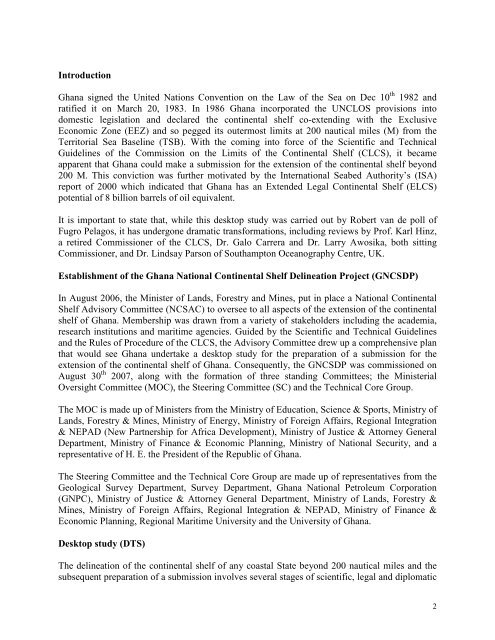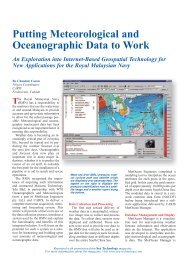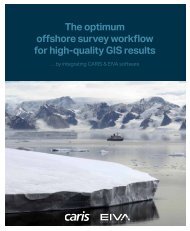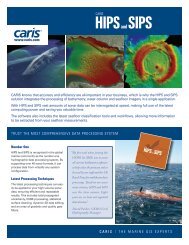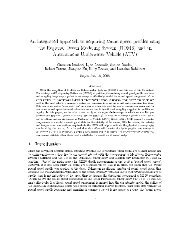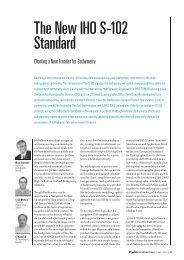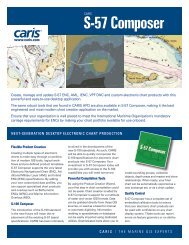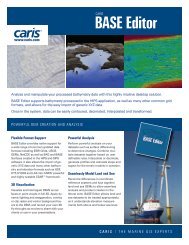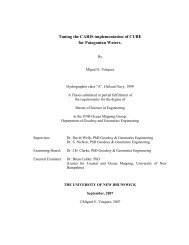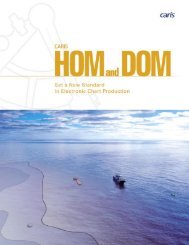APAALSE - Paper - Caris
APAALSE - Paper - Caris
APAALSE - Paper - Caris
- TAGS
- apaalse
- paper
- caris
- www.caris.com
Create successful ePaper yourself
Turn your PDF publications into a flip-book with our unique Google optimized e-Paper software.
Introduction<br />
Ghana signed the United Nations Convention on the Law of the Sea on Dec 10 th 1982 and<br />
ratified it on March 20, 1983. In 1986 Ghana incorporated the UNCLOS provisions into<br />
domestic legislation and declared the continental shelf co-extending with the Exclusive<br />
Economic Zone (EEZ) and so pegged its outermost limits at 200 nautical miles (M) from the<br />
Territorial Sea Baseline (TSB). With the coming into force of the Scientific and Technical<br />
Guidelines of the Commission on the Limits of the Continental Shelf (CLCS), it became<br />
apparent that Ghana could make a submission for the extension of the continental shelf beyond<br />
200 M. This conviction was further motivated by the International Seabed Authority’s (ISA)<br />
report of 2000 which indicated that Ghana has an Extended Legal Continental Shelf (ELCS)<br />
potential of 8 billion barrels of oil equivalent.<br />
It is important to state that, while this desktop study was carried out by Robert van de poll of<br />
Fugro Pelagos, it has undergone dramatic transformations, including reviews by Prof. Karl Hinz,<br />
a retired Commissioner of the CLCS, Dr. Galo Carrera and Dr. Larry Awosika, both sitting<br />
Commissioner, and Dr. Lindsay Parson of Southampton Oceanography Centre, UK.<br />
Establishment of the Ghana National Continental Shelf Delineation Project (GNCSDP)<br />
In August 2006, the Minister of Lands, Forestry and Mines, put in place a National Continental<br />
Shelf Advisory Committee (NCSAC) to oversee to all aspects of the extension of the continental<br />
shelf of Ghana. Membership was drawn from a variety of stakeholders including the academia,<br />
research institutions and maritime agencies. Guided by the Scientific and Technical Guidelines<br />
and the Rules of Procedure of the CLCS, the Advisory Committee drew up a comprehensive plan<br />
that would see Ghana undertake a desktop study for the preparation of a submission for the<br />
extension of the continental shelf of Ghana. Consequently, the GNCSDP was commissioned on<br />
August 30 th 2007, along with the formation of three standing Committees; the Ministerial<br />
Oversight Committee (MOC), the Steering Committee (SC) and the Technical Core Group.<br />
The MOC is made up of Ministers from the Ministry of Education, Science & Sports, Ministry of<br />
Lands, Forestry & Mines, Ministry of Energy, Ministry of Foreign Affairs, Regional Integration<br />
& NEPAD (New Partnership for Africa Development), Ministry of Justice & Attorney General<br />
Department, Ministry of Finance & Economic Planning, Ministry of National Security, and a<br />
representative of H. E. the President of the Republic of Ghana.<br />
The Steering Committee and the Technical Core Group are made up of representatives from the<br />
Geological Survey Department, Survey Department, Ghana National Petroleum Corporation<br />
(GNPC), Ministry of Justice & Attorney General Department, Ministry of Lands, Forestry &<br />
Mines, Ministry of Foreign Affairs, Regional Integration & NEPAD, Ministry of Finance &<br />
Economic Planning, Regional Maritime University and the University of Ghana.<br />
Desktop study (DTS)<br />
The delineation of the continental shelf of any coastal State beyond 200 nautical miles and the<br />
subsequent preparation of a submission involves several stages of scientific, legal and diplomatic<br />
2


